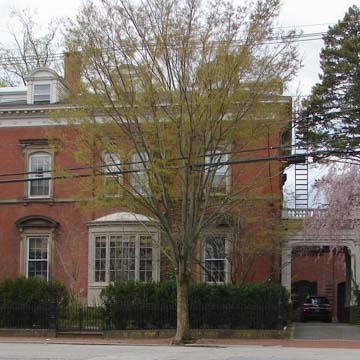Numbers 103 and 108 are Second Empire mansarded houses, one certainly and one probably by Alpheus Morse, for two textile manufacturers. The relative clapboarded modesty and rather plain treatment of the William Sayles house in the company of other Prospect Street residences belies his powerful business position as head of one of the largest textile companies in the country, with a sizable family estate in Pawtucket, shared as an enclave with other members of the family. However, the grand scale of the house and its marble-paved terrace in front, as a platform for the entrance porch, magnify its impact. It was he who gave Sayles Hall to Brown to memorialize the death of his son while a student there.
Across the street, James Kimball, a banker as well as a textile industrialist, lived in a brick block with brownstone trim which exploded the popular East Side three-bay mansard type with tall openings into what may be the largest-scale house on the East Side. Scroll keystones, rosetted entablature, and bracketed eaves sparingly but tellingly embellish the trim. The side carriage entrance with porte-cochere (and a two-story brick carriage house behind) originally signaled another of those Victorian L-shaped corridor plans. The front entrance, however, has been replaced by a frankly modern bow window, and the onetime corridor space behind it merged with its flanking parlors to create one large room across the front. Fences in front of both mansions remind us of the importance of these mostly vanished Victorian features, and so does the effect of the meticulous maintenance of the Kimball landscaping.




















